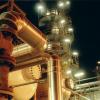Hopefully i can explain your questions
I have attached PSV sizing (simulation model as per Shell DEP) for fire case for Production separator , which is a 3 phase separator. This is how we do in our earlier company, i could not understand why we flash 5% and 10% mass flow and why we subtract those mass flows to get the latent heat . Please explain this .
For a multi-component mixture is very important to evaluate the relieving rate through out the duration of the fire.
At the start of the fire, the lighter ends will boil off first (Stream 46) - the first 5%
The remaining liquid (47) continues to boil and the next components boil off (48) - the next 10%
Often we continue the process, boiling the remaining liquid (49) until the majority is vapourised.
We can then determine the required reliving rate at each step.
There might be a particular component concentration that all boils together that governs this fire case
why we subtract those mass flows to get the latent heat . Please explain this .
Another question is that , the temperature is also adjusted by using SET to bring the temperature of stream downstream of the heater to the temperature of the stream near the first 2 phase separator . Can anyone please explain this.
This appears to be a method your company uses to determine the latent heat of vapourisation.
There must be some acknowledgement that the latent heats of vapourisation that Hysys reports don't represent this particular flash step
They are looking to determine heat or duty required to vapourise just stream 48 (the NET energy required)
E-101-2 is the total stream flow, including all the work to heat up stream 55 and to vapourise stream 48
.
Steam 55 is returned to the initial temperature, as this is the residual liquid that didn't vapourise, so this is the duty didn't go into vapourising stream 48
E-102 is the duty of this residual liquid stream, while its cooled down, its representing part of the duty in E101-2.
By subtracting the two duties [kW or kJ/s], you are left with the energy to vapourise stream 48
By then dividing by the mass flow [kg/s], you are determining the heat of vapourisation of stream 48 [kJ/kg]

 FB
FB












